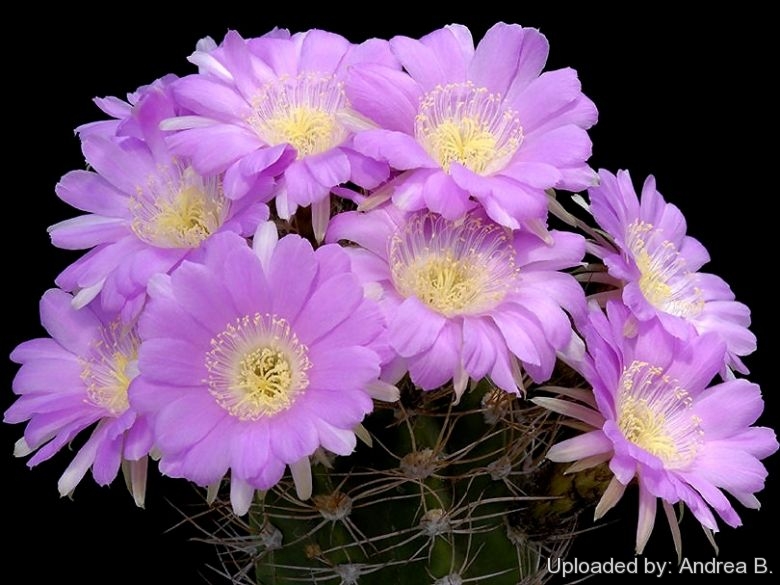




Your support is critical to our success.
Accepted Scientific Name: Echinopsis caineana (Cárdenas) D.R.Hunt
Bradleya 9: 88 (1991)

Origin and Habitat: Rio Caine and adjacent areas, Charcas province, Potosí and Cochabamba, Bolivia
Altitude: 2000-2600 metres above sea level.
Habitat: This species is often found together with Sulcorebutia brevifloraSN|5101]]SN|5101]].
Synonyms:
- Echinopsis caineana (Cárdenas) D.R.Hunt
- Lobivia caineana Cárdenas
Description: Echinopsis caineanaSN|10698]]SN|10698]] ( = Lobivia caineanaSN|10699]]SN|10699]]) distingusces from most of the Lobivias, that are small and globular, for its more columnar grass green stems.
Habit: Plants mostly solitary.
Roots: Shallow.
Stem: Egg-shaped to shortly cylindical, depressed apically, fresh green, 10-29 cm high, 7-9 cm Ø.
Ribs: About 9, straight vertical, prominent above, blunt below.
Areoles: Elongate, cream-white to grey, up to 2,5 cm distanced.
Spines: 14-18, whitish, grey, to brown-black, with dark tips, 1,5-7 cm long, stiff, awl shaped, curved, unequal, some diverging, others erect.
Flowers The flowers arise near the crown at the stem tips, 4-6 Ø funnelform, clear pink, deep violet-rose, or magenta (rarely white).
Blooming season: It flowers during the day in mid spring on into summer. Sometimes it blooms profusely in several consecutive burst, especially on older plants.
Fruits: Ovoid, nearly dry, to 2 cm long.
Bibliography: Major references and further lectures
1) Edward Anderson “The Cactus family” Timber Press, Incorporated, 2001
2) James Cullen, Sabina G. Knees, H. Suzanne Cubey "The European Garden Flora Flowering Plants: A Manual for the Identification of Plants Cultivated in Europe, Both Out-of-Doors and Under Glass" Cambridge University Press, 11/Aug/2011
3) David R Hunt; Nigel P Taylor; Graham Charles; International Cactaceae Systematics Group. "The New Cactus Lexicon" dh books, 2006
4) Walter Rausch “Lobivia: The Day Flowering Echinopsidinae from a Geographical Distribution Point of View, Volums 1-3” R. Herzig, 1975
Cultivation and Propagation: Echinopsis caineanaSN|10698]]SN|10698]] grows rather slowly and it is sensitive to overwatering (rot prone) and needs a very good drainage to avoid rotting, but requires more moisture than true desert cacti to grow and produce flower. It is a very easy flowerer, if you keep it reasonably cool and absolutely dry during winter and lots of fresh air and sunshine tends to produce better plants and more flowers.
Soil: Use a loose well drained cactus mix.
Repotting: It require a deep pot suited to accommodate the swollen root, repotting with fresh potting-mix should be done every other year or when the plant has outgrown its pot. However, repotting doesn't necessarily mean they'll need larger containers.
Sun Exposure: Light shade when young, full sun later. Outside it likes strong sunshine, but is tolerant and do well with light shade during the hot Summer months. Tends to bronze in strong light, which encourages spine production.
Hardiness: It is cold resistant to -10° ( or even less depending on clones) for short periods of time. It will show its flowers only if we provide an adequate winter rest period.
Watering: Water regularly through the growing season. This can be done weekly or more frequently during the summertime, if the weather is sunny enough, but allow to dry fully before watering again. Kept this way, plants will show a healthy growth. Keep rather dry as soon as the temperature starts dropping in October and keep it dry in winter. The plant survives outside without protection in winter but is then somewhat prone to rot, too.
Fertilization: Give an occasional high potassium liquid feed during the active growing period.
Garden uses: It is a fine plant for a rock garden or container, contrasts well with agaves, yuccas, and low-growing flowering plants.
Pest and diseases: They are generally fairly easy to grow, especially if kept pest-free. They are susceptible to, scale insects and spider mite. Watch carefully for infestations of stem and root mealy bugs, and damage from these may well initiate fungal attack.
Propagation: Seeds, also can be grown from cutting if available. Take cuttings spring or summer, let them dry till the ends callous well. Then replant them in fresh cactus soil that is ever so slightly moist, and keep it that way till they root. Surface sowing is the best; seeds germinate in 14-28 days at 20° C , remembering that seedlings dislike strong light and dry conditions.
| Your Actions | |
|---|---|
| Back to Lobivia index | |
| Back to Cactaceae index | |
 |
Back to Cacti Encyclopedia index |
Privacy stantement - Terms and conditions - How to cite - About us - Feedback - Donate



